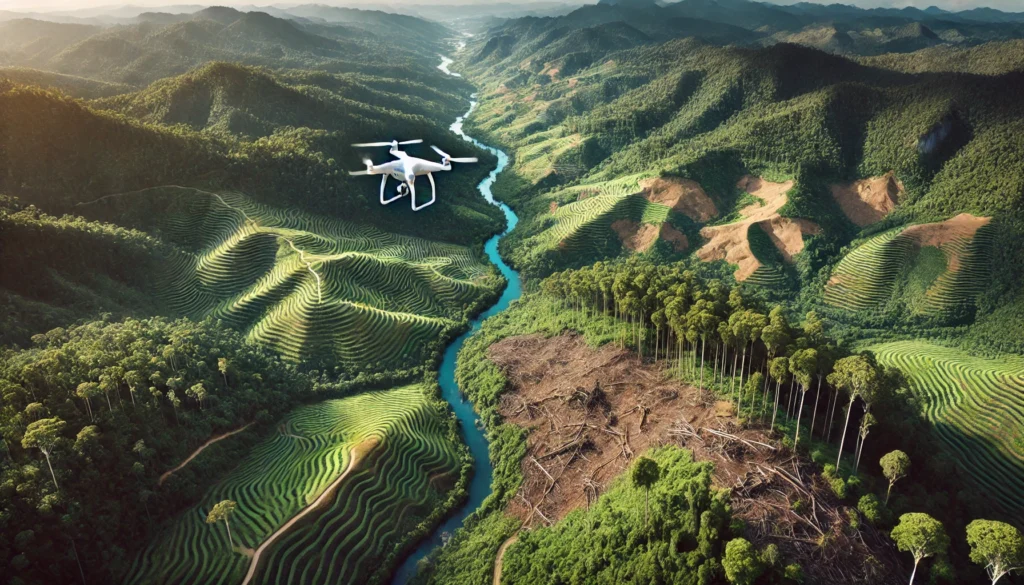Have you ever wondered how scientists keep track of elusive wildlife in vast forests or rugged terrains? The answer increasingly lies in the sky with conservation drones. These high-tech gadgets are revolutionizing how we monitor and protect wildlife. Conservation drones are invaluable tools in India, where diverse ecosystems support an incredible array of species. Let’s explore how these flying marvels make a difference in wildlife conservation.
What are Conservation Drones?
Conservation drones are unmanned aerial vehicles (UAVs) used explicitly for monitoring wildlife and natural habitats. Equipped with cameras and sensors, these drones can capture high-resolution images and videos, providing researchers with vital data. Unlike traditional methods, drones can quickly cover large areas without disturbing the animals.
The Importance of Conservation Drones in India
India’s wildlife is incredibly diverse, from the majestic Bengal tiger to the endangered Great Indian Bustard. Protecting these species requires constant monitoring and data collection. Conservation drones offer several advantages:
Accessibility: Drones can reach remote and difficult-to-access areas, such as dense forests and high mountains.
Efficiency: They can cover large areas in a short amount of time, making data collection faster and more comprehensive.
Non-Invasive Monitoring: Drones allow observation without disturbing the animals, reducing stress and potential harm.

How Conservation Drones Work
Conservation drones are equipped with advanced technology that enables them to perform various tasks:
High-Resolution Cameras: Capture detailed images and videos of wildlife and their habitats.
Thermal Imaging Detects animals based on their heat signatures, which is useful for nocturnal species or those hidden in dense foliage.
GPS and Mapping Software: Create accurate maps and track animal movements over time.
Artificial Intelligence (AI): Analyze data to identify species, count populations, and monitor behavior.
Applications of Conservation Drones in India
Wildlife Population Monitoring:
-
- Tigers in the Sundarbans: Conservation drones help track tiger populations in the dense mangroves of the Sundarbans, providing crucial data for their protection.
-
- Elephants in Assam: In Assam, drones monitor elephant herds, predicting their movements to help prevent human-wildlife conflicts.
Anti-Poaching Efforts:
-
- Kaziranga National Park: Known for its one-horned rhinoceros, Kaziranga has deployed drones to patrol the park and deter poachers. The aerial surveillance allows rangers to respond quickly to any suspicious activity.
Habitat Assessment:
-
- Western Ghats: Drones are used to assess the health of forests in the Western Ghats, identifying areas affected by deforestation or invasive species.
-
- Coral Reefs in Andaman and Nicobar Islands: Aerial surveys of coral reefs help monitor bleaching events and the impact of climate change on marine biodiversity.
Research and Education:
-
- Indian Institute of Science (IISc): Researchers use drones to study animal behavior and interactions in natural settings. The data collected aids in scientific studies and conservation strategies.
-
- Public Awareness Campaigns: Images and videos captured by drones are powerful tools for raising awareness about wildlife conservation among the public.
Challenges and Solutions
While conservation drones offer many benefits, they also come with challenges:
Cost and Maintenance: High-quality drones can be expensive and require regular maintenance. Solutions include seeking funding from government grants, NGOs, and corporate sponsors.
Technical Expertise: Operating drones and analyzing data requires specialized skills. Training programs and partnerships with technology institutes can build the necessary expertise.
Regulatory Hurdles: Drones are subject to aviation regulations that can restrict their use. It is essential to work with regulatory bodies to establish clear guidelines for conservation purposes.
Successful Initiatives in India
Several initiatives in India highlight the successful use of conservation drones:
The Wildlife Institute of India (WII): WII uses drones to monitor wildlife in various national parks, including tracking the movement of endangered species like the Asiatic lion in Gir National Park.
WWF-India: World Wildlife Fund (WWF) India employs drones for anti-poaching efforts and habitat monitoring across different conservation projects.
The Future of Conservation Drones
The future of conservation drones in India looks promising. As technology advances, drones will become more affordable, efficient, and accessible. Integrating AI and machine learning will enhance data analysis, providing deeper insights into wildlife behavior and ecosystem health. Moreover, community involvement and local partnerships will ensure the sustainable use of drones for conservation.
Conclusion
Conservation drones are transforming the way we monitor and protect wildlife in India. Providing a bird’s-eye view of our natural world enables researchers and conservationists to gather crucial data, deter illegal activities, and promote sustainable practices. As we continue to embrace this technology, we can look forward to a future where drones play an integral role in preserving India’s rich biodiversity.
Author’s Note
Thank you for exploring the exciting world of conservation drones with me. If you found this blog informative and engaging, please share it with others passionate about wildlife conservation. Together, we can make a difference in protecting our planet’s incredible wildlife.
G.C., Ecosociosphere contributor.
References and Further Reading:
- Wildlife Institute of India
- WWF-India
- Day 4 of AI for Land Surveyors: Embracing the Future: Understanding AI’s Role in Our Lives – Not a Camera – Land Surveyors United – Global Surveying Community. https://landsurveyorsunited.com/hubs/ai/forum/topics/day-4-of-ai-for-land-surveyors-are-you-afraid-of-ai
- Asseti – Main Website. https://www.asseti.co/news/detect-diagnose-and-prevent-the-three-pillars-of-effective-asset-condition-assessment
- Assam Tourist Places | Places to Visit in Assam | celebrity news. https://celebritynews.pk/assam/
- AI-driven personalized nutrition plans for better health – Classic nature prints. https://classicnatureprints.com/ai-driven-personalized-nutrition-plans-for-better-health/
- A Fingerprint Lock for Door: Smart Choice for Home Security. https://www.teeho.com/blogs/news/fingerprint-lock-for-door




